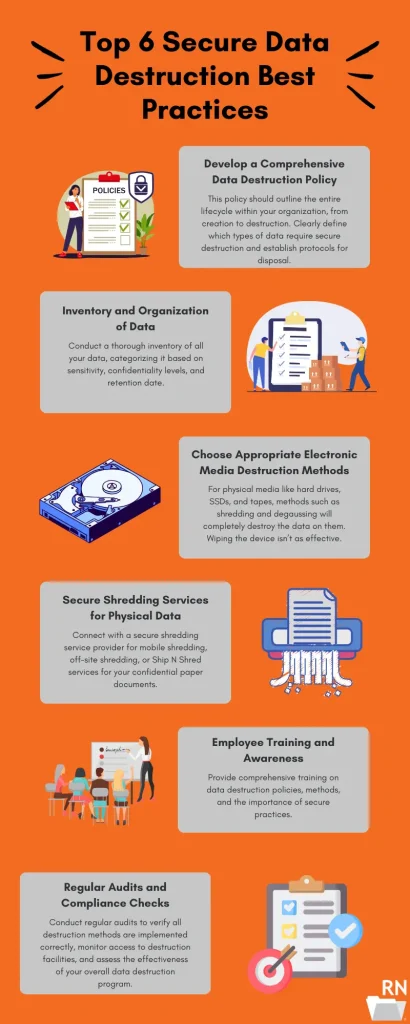
Our lives and businesses revolve around data. From important work documents to personal photos, our information is valuable. But what happens when we no longer need that data? How do we ensure it’s gone for good, especially when we want to keep it away from prying eyes? Secure data destruction is critical for businesses and individuals.
Whether it’s protecting sensitive business data or ensuring the privacy of personal information, implementing strong data destruction practices is essential. This blog will explore the best practices for secure data destruction, guiding you through the steps to safeguard your valuable information.
1. Develop a Comprehensive Data Destruction Policy
Before diving into the specifics of data destruction methods, it’s crucial to establish a comprehensive data destruction policy. This policy should outline the entire data lifecycle within your organization, from creation to destruction. Clearly define which types of data require secure destruction and establish protocols for the disposal of various storage media.
A well-defined data destruction policy serves as the foundation for implementing effective practices, ensuring that all employees understand their role in maintaining the security of sensitive information.
2. Inventory and Organization of Data
Conduct a thorough inventory of all data within your organization, categorizing it based on sensitivity and confidentiality levels. In addition, you should also organize by the document’s retention date. This step is essential for determining which data requires a higher level of security during destruction. Classifying data ensures that your data destruction efforts are targeted and proportional to the risk associated with each type of information. You will also be able to keep in compliance with the various retention laws for specific documents.
3. Choose Appropriate Electronic Data Destruction Methods
Different types of data require different destruction methods. For physical media like hard drives, SSDs, and tapes, methods such as shredding or degaussing are effective. For digital data on storage devices, employing data-wiping software with industry-standard algorithms ensures a thorough erasure process. However, even if you wipe your data, thieves can still recover information on them with other software. Once the device comes to its end of life, you still need to destroy the hard drive to completely destroy the data.
4. Secure Shredding Services for Physical Data
Partner with a secure shredding service provider for your paper documents. Our service providers adhere to industry standards for security and confidentiality. You have a few different options to choose from depending on your needs:
- Mobile Shredding: This is the most secure type of shredding service. The shred truck will come right to your location and shred while you watch. They can handle any size project, and you will receive a certificate of destruction for your records when the job is complete.
- Off-Site Shredding: With off-site shredding, a service provider will pick your documents up and take them to a secure shredding facility to be shredded. This service can also handle any size project. While you won’t get to witness the shredding, you will still receive a certificate of destruction when the process is complete.
- Ship N Shred: This is a unique service that allows you to ship your documents through FedEx to be shredded at a secure facility. You can ship as many boxes as you need, track the entire process, and receive a certificate of destruction at the end.
5. Employee Training and Awareness
Your data destruction practices are only as strong as the awareness and diligence of your employees. Provide comprehensive training on data destruction policies, methods, and the importance of secure practices. Regularly reinforce the importance of secure data handling and destruction through ongoing awareness campaigns.
6. Regular Audits and Compliance Checks
Conduct regular audits of your data destruction processes to ensure compliance with industry regulations and internal policies. This includes verifying that all destruction methods are implemented correctly, monitoring access to destruction facilities, and assessing the effectiveness of your overall data destruction program.
Compliance checks are particularly crucial for organizations operating in regulated industries. Ensure that your data destruction practices align with legal requirements and industry standards to mitigate the risk of legal consequences and reputational damage.
Get Secure Data Destruction Services From Record Nations Today!
By following these best practices, you not only meet compliance standards but also demonstrate a commitment to data security that can enhance your organization’s reputation. Contact Record Nations at (866) 385-3706, fill out the form, or use our live chat to connect with a data destruction professional today.













